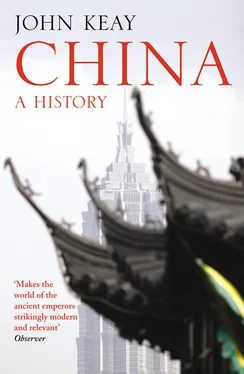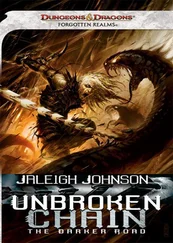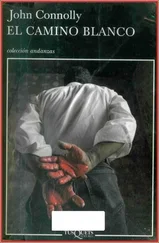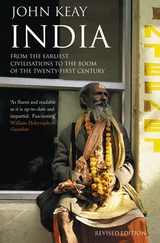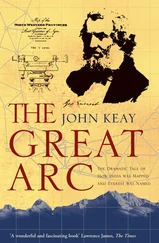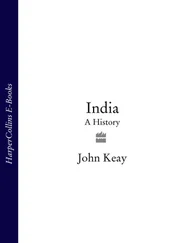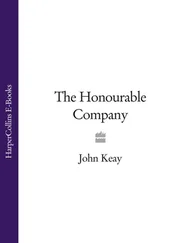Dying just 150 years after Tutankhamun, a Shang royal consort called Fu Hao was interred at the Anyang site around 1200 BC and remained undisturbed until AD 1976. The tomb is a small one, without ramps. ‘Lady Hao’ – her name is found engraved on her bronzes – may have been cherished but she was too gender-handicapped to merit more than ‘a lesser tomb’ with a simple shaft of room-size dimensions about 7.5 metres (25 feet) deep. Her burial chamber was nevertheless richly furnished. The nested coffins, though badly decayed by seepage, had once been lacquered red and black; the walls had probably been painted and textiles draped over the coffin. Most of the surviving grave goods must have originally been inside the outer coffin. Yet the inventory for this fairly small space included 195 bronze vessels (the largest of which weighed 120 kilograms – 265 pounds), more than 271 smaller bronze items, 564 objects of carved bone and an extraordinary 755 of jade, the largest such collection ever found. ‘If the [bigger] tombs were richer than this, their contents are beyond imagining,’ says Bagley. 10
Sixteen skeletons were also found in the tomb. They were distributed within, around and above the coffin. The Shang elite did not like its members to leave this world alone; relatives, retainers, guards, servants and pets accompanied them as part of the grave offering. Ritual demanded, and spectacle no doubt encouraged, human sacrifice on a grand scale. In the larger tombs the victims have been counted in their hundreds. Some skeletons are complete, others dismembered or decapitated, the cranium often having been sawn off, perhaps for bone carving. Some of the mutilated victims may have been convicts or captives taken in war. The killing of prisoners is thought to have been common practice, and the skeletons include different racial types. The quality of Shang mercy, if such a thing existed, was ever strained and made no clear distinction between friend and foe. Men (and occasionally women and children) were as conspicuously expended in the cause of ritual as were bronze and jade.
How all this extravagance was funded is unclear. No great agricultural revolution occurred at the time, no major irrigation effort is known, and no significant introduction – the ox-drawn plough once had its champions – has been generally accepted. Nor do trade or conquest seem to have been important contributory factors. The Shang apparently just used existing resources of land and labour to greater effect. ‘This leads to the inevitable conclusion’, writes Kwang-chih Chang of the Academia Sinica, ‘that the Shang period witnessed the beginning in this part of the world of organised large-scale exploitation of one group of people by another within the same society’; it also witnessed ‘the beginning of an oppressive governmental system to make such exploitation possible’. 11
While members of the ruling clans frequented the great buildings whose pounded earth foundations testify to ambitious architecture and gracious living, the ‘black-haired commoners’ lived in covered pits, used crude clay utensils, and laboured in the fields with Stone Age tools of wood and flint. Malnutrition has been noted in many skeletons. Leisure must have been rare, insubordination fatal. Cultural excellence came at a price in Bronze Age China; the bright burnish of civilisation was down to the hard rub of despotic power.
This somewhat harsh picture of second-millennium BC China may be tempered by further research at those sites that have lately come to light in more distant parts of the country. The Qijia culture of Gansu and Qinghai provinces, for instance, besides providing examples of pre-Erlitou bronze working, was reported in 2005 to have yielded evidence of another abiding ingredient in Chinese civilisation, namely ‘the oldest intact noodles yet discovered’. Dated to about 2000 BC, they were found at a site called Lajia and had been made from millet flour. 12
More elaborate artefacts, including several enormous bronze bells, from sites in Hubei and Hunan provide early testimony of the more vibrant art and culture of the Yangzi region; but they have been eclipsed by finds from further upriver in Sichuan. There two recent discoveries made in and around Chengdu, today a megalopolis of about 12 million, have confounded art historians and left any notion of a single bronze tradition teetering on the edge of the melting pot. Sacrificial pits accidentally discovered at Sanxingdui in 1986, and the site at Jinsha uncovered during road construction in 2001, produced large quantities of animal bones and elephant tusks but not one human skeleton. More sensationally, they yielded an array of bronze busts and figures, gold masks and jades quite unlike anything discovered elsewhere in China. A bronze statue, 2.6 metres (8.5 feet) tall (including its pedestal) and dated to about 1200 BC, is of an elongated and gesticulating figure with stylised features more Aztec than Chinese. Likewise some disassembled bronze fruit trees, like gigantic table decorations complete with foliage, peach-like fruit and frugivorous birds, all of bronze, have no known counterpart.
Also uncovered at Sanxingdui were the hangtu (pounded earth) foundations of a large city. This method of construction has suggested some contact with either Erlitou or Erligang. On the other hand, the temptation to link Sichuan’s sites, however weird and wonderful, with later kingdoms in the same region known in the texts as Shu and Ba has proved irresistible. A similar connection has been proposed between the Hubei/Hunan bronze sites and the Yangzi region’s later kingdom of Chu. Inconvenient data is thus yoked to the orthodoxies of textual tradition, and unaccountable art forms accommodated within the framework of existing research.
No such accommodation, however, has yet been extended to the most controversial discovery of all. In 1978 the Chinese archaeologist Wang Binghua unearthed a large collection of graves at Hami in the deserts of eastern Xinjiang province. It was not where one would expect to find an ancient culture of any relevance to the more favoured parts of China; if Chengdu is as far from Beijing as Denver from New York, Hami might be likened to some place in remotest Idaho.
Similar graves had been noted thereabouts by European travellers earlier in the twentieth century, though without exciting their interest. The new graves were dated to about 1200 BC, but of their contents little was heard until ten years after Wang’s discovery. It was then, in 1988, that Victor Mair, an American academic who was guiding a tour for the Smithsonian Institute, wandered into a new section of the provincial museum in Urumqi, the Xinjiang capital. Parting the hanging curtains that served as a door, he pushed inside and thus famously ‘entered another world’.
The room was full of mummies! Life-like mummies! These were not the wizened and eviscerated pharaohs wrappped in yards of dusty gauze that one normally pictures when mummies are mentioned. Instead they were everyday people dressed in their everyday clothes. Each one of the half dozen bodies in the room, whether man, woman or child, looked as if it had merely gone to sleep for a while and might sit up at any moment and begin to talk to whomever happened to be standing next to its glass case. 13
Mair was transfixed; as a scholar of early Eastern linguistics and literature, he might actually have understood any rasped utterances coming from the desiccated corpses. He gave them all names and called one after his brother; the resemblance was uncanny. This ‘Ur-David’ (‘the first David’), or ‘Charchan Man’, lay with his head on a pillow and ‘his expressive hands placed gently upon his abdomen’. His woollen shirt and trousers were in a fetching shade of maroon ‘trimmed with fine red piping’. Inside his white thigh-length boots he wore felt socks ‘as brightly coloured as a rainbow’.
Читать дальше
